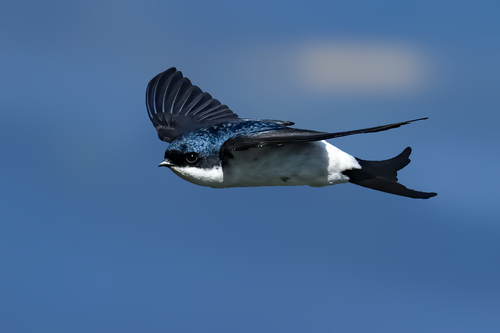
Common House-martin
The Common House-Martin (*Delichon urbicum*) is a migratory bird known for its distinctive aerial lifestyle and close association with human settlements. It plays a vital role in controlling insect populations, particularly in urban and agricultural areas. While not holding any major specific cultural significance beyond general appreciation for swallows and martins as symbols of summer and good fortune, the house martin's presence is often welcomed as a sign of a healthy environment.
13-15 cm
Length
26-29 cm
Wingspan
Least Concern
Conservation Status
Distribution
The Common House-Martin breeds across Europe, North Africa, and temperate Asia. It migrates to sub-Saharan Africa and tropical Asia for the winter. Its altitudinal range extends from sea level to at least 2,200 meters.
Lifespan
Typically 2-3 years in the wild, but up to 5 years has been recorded. In captivity, lifespan is Not Evaluated.
Common House-martin's Habitat
Habitat Types
Open Countryside, Urban Areas, Suburban Areas, Cliffs, Agricultural Land
Climate Zones
Temperate, Mediterranean, Boreal
Adaptations
House-Martins have adapted to human-altered landscapes by utilizing buildings for nesting. They require a source of mud for nest building, often found near water bodies. Their agile flight allows them to forage effectively in open spaces, and their social nesting behavior provides protection from predators.
Variations
Two main subspecies are generally recognized: *D. u. urbicum* (Europe and western Asia) and *D. u. lagopodum* (eastern Asia). The eastern subspecies is slightly larger and has more extensive white on the rump.
Appearance
Breeding Plumage
No significant difference between breeding and non-breeding plumage.
Seasonal Feather Changes
Adult plumage remains consistent year-round. Juveniles have duller plumage with less defined markings.
Sex Based Plumage Differences
Males and females have very similar plumage.
Notable Features
Glossy blue-black upperparts, Pure white underparts and rump, Short, forked tail, White-feathered legs and feet
Diet and Feeding
Primary Foods
Flying insects, Aphids, Flies, Small beetles
Foraging Behavior
House-Martins are aerial insectivores, catching their prey on the wing. They often forage in flocks, particularly over water bodies or near livestock where insects are abundant. They can forage at various heights, from near ground level to high above.
Specializations
Their short, wide gape is adapted for capturing insects in flight. Their agility and maneuverability allow them to pursue fast-flying prey.
Seasonal Diet Variations
Diet is primarily dictated by insect availability. During breeding season, larger insects may be preferred to provide sufficient energy for chicks.
Behavior
Social Structure
Highly social, often nesting in colonies that can range from a few pairs to several hundred. They also forage and migrate in flocks.
Communication
Chirping calls, Chattering sounds, Contact calls during flight
Migration
Common House-Martins are long-distance migrants. European populations travel south of the Sahara Desert in Africa for the winter, following routes that often cross the Mediterranean Sea and the Sahara. The exact routes and timing vary depending on the breeding location.
Territorial or Group Behaviors
While colonial, pairs defend a small territory immediately around their nest. They exhibit group mobbing behavior to deter predators like birds of prey.
Conservation
Threats
Habitat loss (loss of nesting sites), Pesticide use (reducing insect prey), Climate change (affecting migration and breeding), Nest destruction by humans
Protection Programs
Provision of artificial nest cups, Habitat restoration projects, Awareness campaigns to prevent nest destruction
Local National Laws
Protected under various national wildlife laws in many European countries, such as the Wildlife and Countryside Act 1981 in the UK.
Population Trend
Decreasing in some regions, particularly in parts of Western Europe, but the global population is still considered large.
Population Estimates
The global population is estimated to be between 20,000,000 and 48,000,000 mature individuals.
Interesting Facts
They build their nests with over 1000 mud pellets.
Each pellet is collected individually and carefully shaped to form the enclosed nest.
House-Martins often return to the same nesting site year after year.
This site fidelity demonstrates their strong attachment to successful breeding locations.
They can fly thousands of kilometers during migration.
Their journey to and from Africa is a remarkable feat of endurance.
They are capable to sleep while flying.
During the non-breeding period, they spend almost all their time on the wing.
Faqs about Common House-martin
What should I do if I find a House-Martin nest?
It's best to leave it undisturbed, especially during the breeding season. House-Martins are protected by law in many countries.
How can I attract House-Martins to my garden?
Provide a source of mud and consider installing artificial nest cups under your eaves. Avoid using pesticides.
Do House-Martins reuse their nests?
Yes, they often return to the same nest site and repair or rebuild their nests each year.
What eats House Martins?
House Martins, especially their chicks, are preyed upon by birds of prey like Eurasian Hobbies and Sparrowhawks.
Copyright @ Nature Style Limited. All Rights Reserved.
 English
English